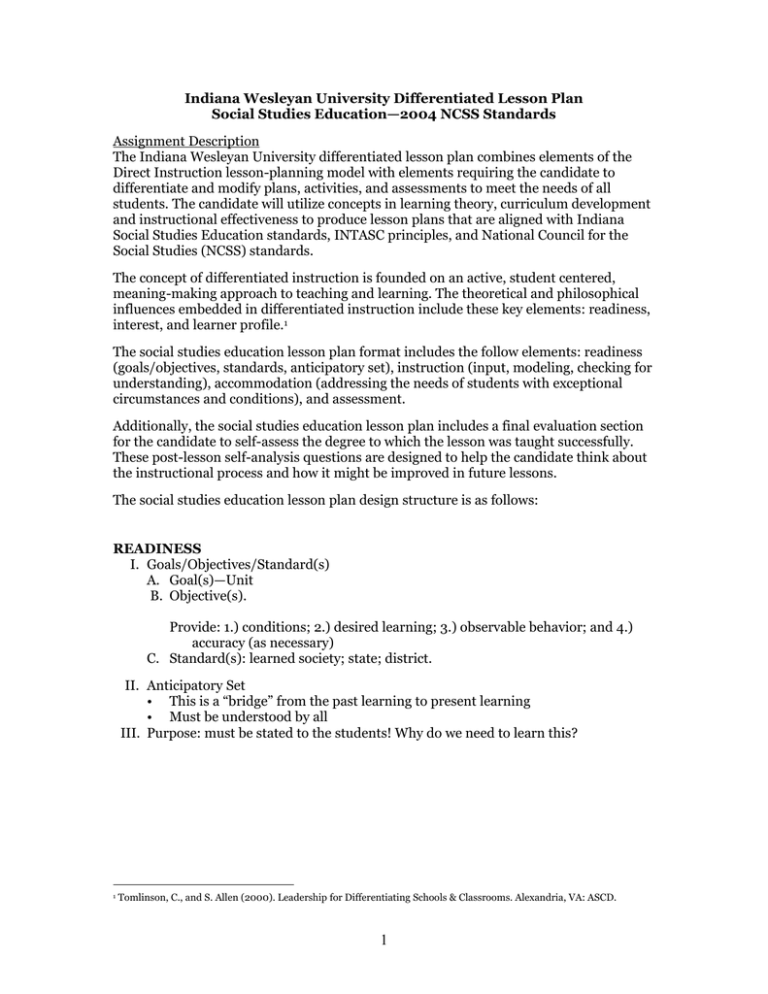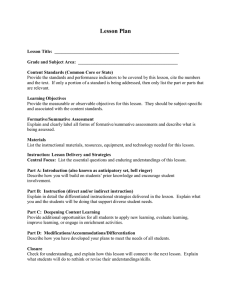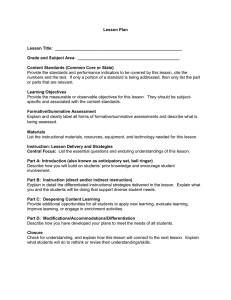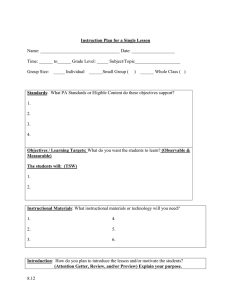Assessment 3—Assessment of Candidate Ability to Plan Instruction
advertisement

Indiana Wesleyan University Differentiated Lesson Plan Social Studies Education—2004 NCSS Standards Assignment Description The Indiana Wesleyan University differentiated lesson plan combines elements of the Direct Instruction lesson-planning model with elements requiring the candidate to differentiate and modify plans, activities, and assessments to meet the needs of all students. The candidate will utilize concepts in learning theory, curriculum development and instructional effectiveness to produce lesson plans that are aligned with Indiana Social Studies Education standards, INTASC principles, and National Council for the Social Studies (NCSS) standards. The concept of differentiated instruction is founded on an active, student centered, meaning-making approach to teaching and learning. The theoretical and philosophical influences embedded in differentiated instruction include these key elements: readiness, interest, and learner profile.1 The social studies education lesson plan format includes the follow elements: readiness (goals/objectives, standards, anticipatory set), instruction (input, modeling, checking for understanding), accommodation (addressing the needs of students with exceptional circumstances and conditions), and assessment. Additionally, the social studies education lesson plan includes a final evaluation section for the candidate to self-assess the degree to which the lesson was taught successfully. These post-lesson self-analysis questions are designed to help the candidate think about the instructional process and how it might be improved in future lessons. The social studies education lesson plan design structure is as follows: READINESS I. Goals/Objectives/Standard(s) A. Goal(s)—Unit B. Objective(s). Provide: 1.) conditions; 2.) desired learning; 3.) observable behavior; and 4.) accuracy (as necessary) C. Standard(s): learned society; state; district. II. Anticipatory Set • This is a “bridge” from the past learning to present learning • Must be understood by all III. Purpose: must be stated to the students! Why do we need to learn this? 1 Tomlinson, C., and S. Allen (2000). Leadership for Differentiating Schools & Classrooms. Alexandria, VA: ASCD. 1 PLAN FOR INSTRUCTION IV. Adaptations: students with special needs. Depending on the nature and complexity of the lesson, what adjustments and/or adaptations will you make to accommodate all students in the class? • Remediation: students who didn’t master the objective(s) • Enrichment: gifted/mastery students • ESL—mainstreamed • Others? V. Lesson Presentation (Input/Output) • Include: active participation and questions to be asked • Include: technology and adaptations for students with special needs • Include: modeling/monitoring VI. Check for understanding. How do you know students have learned? What strategies will you implement if all students have not met lesson outcomes? Employ one or more strategies to determine student learning: • Guided practice. Teacher models; students complete exercises with the teacher; the teacher checks for understanding before students work alone. • Reteach: whole group, small group, individuals • Suggested strategies: index card summaries; hand signals; question board/box; concept maps; oral questioning; follow-up probes; misconception checks VII. Review learning outcomes / Closure VIII. Independent practice/extending the learning • If the checking for understanding has gone well, students are ready to complete an assignment alone. • The assignment must relate directly to learning outcomes. PLAN FOR ASSESSMENT Develop a plan for assessing the degree to which your students have mastered the learning outcomes from this lesson. Your plan should include formative assessments at a minimum, and may also include summative and/or authentic assessments depending on the nature of the learning outcomes and the placement of the lesson within the context of the unit. Formative. Formative assessments are on-going assessments, reviews, and observations in a classroom. Use formative assessment to improve instructional methods and student feedback throughout the teaching and learning process. For example, if some students do not grasp a concept, you might design a review activity or use a different instructional strategy. Likewise, students can monitor their progress with periodic quizzes and performance tasks. The results of formative assessments are used to modify and validate instruction. Summative. Summative assessments are typically used to evaluate the effectiveness of instructional programs and services at the end of lesson or instructional unit. The goal of summative assessment is to make a judgment of student competency after an instructional phase is complete. Summative evaluations are used to determine if students have mastered specific competencies and to identify instructional areas that need additional attention.2 2 Adapted from http://fcit.usf.edu/assessment/basic/basica.html. Taken from the Internet on July 20 2012. 2 Authentic. Authentic assessment is a form of assessment in which students are asked to perform real-world tasks that demonstrate meaningful application of essential knowledge and skills. These tasks—authentic assessments—are either replicas of or analogous to the kinds of problems faced by adults or consumers or professionals in the field. Authentic assessment requires students to demonstrate specific skills and competencies, that is, to apply the skills and knowledge they have mastered. An authentic assessment usually includes a task for students to perform and a rubric by which their performance on the task will be evaluated. 3 Authentic assessment can be either a short-term or long-term assignment for students. There is no specific length of time attached to an authentic assessment learning opportunity. However, "within a complete assessment system, there should be a balance of longer performance assessments and shorter ones" (Valencia, 1997). According to Lawrence Rudner, authentic assessment should require that students be active participants in learning and be able to demonstrate knowledge and skills. The following is a list of examples of authentic assessment that meet one or both of these requirements - active participation and/or demonstration of knowledge and skills. As you read through this list, keep in mind that some of the examples will work better for you depending on your grade level and topic area. Make a note of the examples of assessment that you could use in your own classroom.4 Authentic Assessment examples: ▪ Conduction research and writing a report ▪ Character analysis ▪ Student debates (individual or group) ▪ Drawing and writing about a story or chapter ▪ Experiments - trial and error learning ▪ Journal entries (reflective writing) ▪ Discussion partners or groups ▪ Student self-assessment ▪ Peer assessment and evaluation ▪ Presentations ▪ Projects ▪ Portfolios REFLECTION AND POST-LESSON ANALYSIS 1. How many students achieved the lesson objective(s)? For those who did not, why not? 2. What were my strengths and weaknesses? 3. How should I alter this lesson? 4. How would I pace it differently? 5. Were all students actively participating? If not, why not? 6. What adjustments did I make to reach varied learning styles and ability levels? a. Bloom’s Taxonomy b. Gardner’s Multiple Intelligences Revision Date: July 16, 2012 2004 NCSS Standards 3 4 Adapted from http://jfmueller.faculty.noctrl.edu/toolbox/whatisit.htm. Taken from the Internet on July 20, 2012. Taken from http://tccl.rit.albany.edu/knilt/index.php/Unit_2:_Types_of_Authentic_Assessment on July 23, 2012. 3 Indiana Wesleyan University Social Studies Education Lesson Plan Design and Assessment Rubric Readiness Goals/Objectives /Standards Anticipatory Set Purpose Needs Improvement 1 Lesson objectives are poorly written and/or have little or no connection to learning goals or standards. Little connection exists between objectives and lesson activities and assessments. The anticipatory set is missing or has little or no connection to the goal or content of the lesson. The statement of purpose is ambiguous or worded so generally that the connection with the content of the lesson is not apparent. Emerging Competence 2 Lesson objectives are correlated with learning goals and standards. The connection between objectives and lesson activities and assessments is weak or unclear. The connection between the anticipatory set and lesson objectives and content is weak or unclear. A statement of purpose is included in the LP, but has little power to motivate students and capture their imaginations. Competent 3 The lesson plan contains objectives that connect goals and standards with LP activities and assessments. The anticipatory set is clear and direct and focuses students’ attention on the lesson. The statement of purpose is clearly connected to the content of the lesson and is presented in terms that are easily understood by students. Outstanding 4 The lesson plan contains clearly stated content objectives. Objectives are logically connected to appropriate goals and standards and are consistent with lesson activities and assessments. The anticipatory set connects the current lesson with previous and future learning and focuses students’ minds and attention on the day’s lesson. The statement of purpose has the power to capture the imaginations of students and motivate them to accomplish the expected learning. Instruction Competent 3 Outstanding 4 Few or no adaptations are included for students with special needs. Needs Improvement 1 Lesson adaptations are written generally and/or are not designed to meet specific learning issues of individual students. Emerging Competence 2 Plans for differentiating instruction are included; adequate and appropriate adaptations are included for all students who require them. The presentation does not involve the active participation of students. Essential questions are not listed or are unrelated to the content of the lesson. Little or no provision is made for technology or diverse students. The presentation includes activities that have little relation to the content of the lesson. Essential questions are poorly written or are not adequate for the scope of the lesson. Provisions for technology and diverse students are inadequate. The lesson presentation provides for the active participation of students. Essential questions are listed; provisions for technology and diversity issues are included. The LP includes differentiated instruction for students with special needs; lesson adaptations are thoughtfully and thoroughly planned and are designed to bring all students into full participation and mastery of lesson goals and objectives. The lesson presentation is clearly designed to actively involve all students for the duration of the learning process. Essential questions are designed to cause students to think deeply and critically about the content of the lesson. Technology is integrated seamlessly and appropriately. The learning needs of all students are accounted for in the presentation section. Adaptations: Special Needs Students Lesson Presentation Little or no provision is made for modeling or mentoring of students. Plans for teacher modeling and mentoring of students could be better developed. 4 The modeling and monitoring of student work and learning sections are included in sufficient detail. Teacher modeling and mentoring of students is designed to help all learners understand and master the content of the lesson. Instruction, con’t. Needs Improvement 1 Little or no provision is included to check for student understanding or to reteach concepts that elude students during the initial presentation. Emerging Competence 2 A guided practice section is included in the lesson plan, but the connection with the lesson presentation is weak and/or unclear. Review/closure Lesson closure is not included, or is not related to the goals and/or content of the lesson. Lesson closure is weak and/or poorly written. Independent Practice/ Extending the Learning No independent practice activities are included in the lesson, or activities are unrelated to the content of the lesson. Independent practice activities are not well conceived and/or written; student accomplishment of IP activities is not likely to result in lesson mastery. Assignments or activities are included that provide students with the opportunity to practice learned skills; All activities match lesson objectives. Needs Improvement 1 Self-answer questions are not included in the lesson plan. Emerging Competence 2 Self-answer questions are included, but do not fit the content or purposes of the lesson. Assessment activities are included in the lesson, but they are not well correlated to and/or do not cover the full range of LP goals and objectives. Competent 3 The lesson plan includes all required self-answer questions. Check for Understanding Competent 3 The lesson plan includes a plan and the means to check for student understanding of the lesson. A provision is included to reteach all or part of the lesson to all or part of the class. Lesson closure relates directly to the lesson purpose and/or objective. Outstanding 4 Plans to check for student understanding of the content are an integral part of the lesson, and include frequent questions and other actively engaging forms of formative assessment during guided practice. Lesson closure is clearly correlated to the content of the lesson and actively engages students in summarizing the essential elements of the lesson. Independent practice activities are highly correlated to lesson objectives and content and lead to student mastery. Evaluation Reflection and Post-Lesson Analysis Formative and Summative Assessment The lesson plan does not include assessment activities, or there is little or no correlation between planned assessment activities and lesson goals and objectives. A plan for informal, ongoing assessment throughout the lesson is included. A summative assessment plan is included if appropriate for the lesson. Outstanding 4 Additional self-answer questions are included that specifically address unique lesson content and methodology. Formative and summative assessment activities are a seamless and integrated part of the lesson. Assessment activities are highly correlated with the goals and objectives of the lesson. Revision Date: July 16, 2012 2004 NCSS Standards 5


